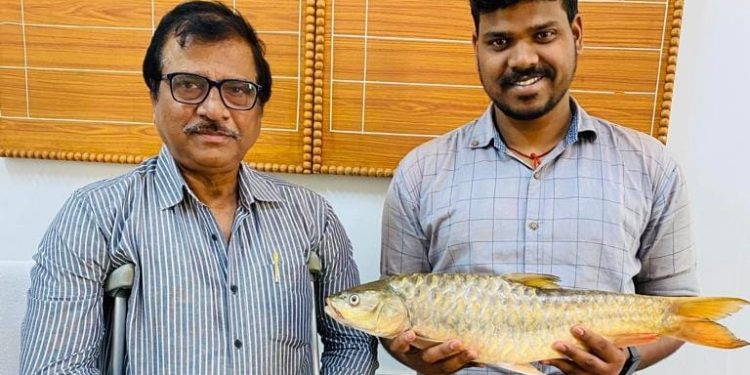Bhubaneswar: In a first, researchers from the Central University of Odisha (CUO) have found two Mahseer species – Tor putitora and Tor tor – in Indravati River, a tributary of the Godavari River, in southern Odisha. According to the team, led by CUO’s School of Biodiversity and Conservation of Natural Resources (SBCNR) Dean Professor Sharat Kumar Palita, Mahseer fish species have earlier been reported from the Mahanadi, Brahmani, and Similipal regions of the state. “It is for the first time they have been reported from any river in southern Odisha, with Tor putitora being a new record for the entire Godavari Basin in India,” Palita said. These two new Mahseer fish species belong to the Cyprinidae family, which are large-bodied and big scaled carps, often called ‘King of the Indian aquatic system’ and are included under 20 mega fishes of the world. “They inhabit fast-flowing cold, clear, hilly riverine water with pebbly, stony, and rocky bottoms and intermittent rocky pools. They are sacred and worshipped in many Hindu temples in India,” he said. Palita said he began research on Mahseer fish soon after joining CUO around six years ago. “These fishes were initially documented from Indravati Market at Khatiguda in Nabarangpur district. Later, they were found from Indravati Reservoir at Mukhiguda in Kalahandi and Kapur Dam in Nabarangpur,” he said. CUO laboratory identified those as Mahseer fishes and later, the Zoological Survey of India in Kolkata confirmed those as two Mahseer species— Tor putitora (ZSI Registration No. FF8623, 30cm) and Tor tor (ZSI Registration No. FF8624, 33.6cm). “Tor tor has earlier been recorded from Similipal, Mahanadi River System and Brahmani River,” he said. CUO Vice-Chancellor Professor Chakradhar Tripathi and Vice-Chancellor (I/c) Professor NC Panda congratulated the team, comprising researchers Alok Kumar Naik and Anirban Mahata, for the feat. The findings were published in the Asian Journal of Conservation Biology. Globally, Mahseer species belong to three genera – Tor, Neolissochilus, and Nazirtor. Members of the Tor genus are regarded as ‘True Mahseer.’ There are 17 valid Tor species globally, found in countries like India, China, Bangladesh, Nepal, Sri Lanka, Myanmar, Thailand, Indonesia, Pakistan, and Afghanistan. India now hosts nine species of Tor Mahseer. With this discovery, Odisha has four recognised Mahseer species – Tor tor, Tor mahanadicus, Tor putitora, and Tor khudree. Locally, these fish are known as ‘Kainsari’ or ‘Khaiser’ in Khatiguda area of Nabarangpur, while Bengali communities refer to them as ‘Mahasol.’ In India, Mahseer are prized both as game fish and for their culinary value. The Golden Mahseer can grow up to 275cm in length and weigh up to 54kg. Mahseer is increasingly considered a candidate species for aquaculture due to its sport fishing appeal and excellent flesh quality. However, various human activities such as untreated sewage discharge and pollution have significantly altered the natural habitats of Mahseer in India, including Odisha. The IUCN has classified Tor putitora as ‘Endangered’ and Tor tor as ‘Near Threatened,’ emphasising the need for conservation efforts.
Hungary Lessons
Revolting against oppression and seeking freedom is ingrained in human nature, something that a repressive regime finds out sooner or...
Read more





































